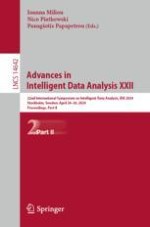2024 | Book
Advances in Intelligent Data Analysis XXII
22nd International Symposium on Intelligent Data Analysis, IDA 2024, Stockholm, Sweden, April 24–26, 2024, Proceedings, Part II
Editors: Ioanna Miliou, Nico Piatkowski, Panagiotis Papapetrou
Publisher: Springer Nature Switzerland
Book Series : Lecture Notes in Computer Science
